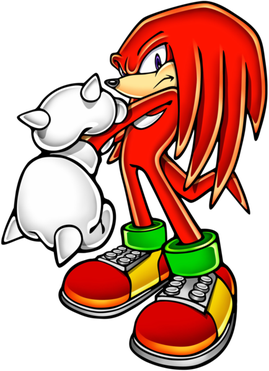
Knuckles the Echidna is a character from Sega's Sonic the Hedgehog series. He is a red anthropomorphic short-beaked echidna who is Sonic's secondary best friend and former rival. Determined and serious, but sometimes gullible, he fights his enemies using brute force and strength. His role is established as the guardian of the Master Emerald, a large gemstone which controls the series' integral Chaos Emeralds, and is the last living member of his tribe, the Knuckles clan.

Sonic Adventure is a 1998 platform game developed by Sonic Team and published by Sega for the Dreamcast. It was the first main Sonic the Hedgehog game to feature 3D gameplay. It follows Sonic the Hedgehog, Miles "Tails" Prower, Knuckles the Echidna, Amy Rose, Big the Cat, and E-102 Gamma in their quests to collect the Chaos Emeralds and stop Doctor Robotnik from unleashing Chaos, an ancient evil. Controlling one of the six characters—each with their own abilities—players complete levels to progress the story. Sonic Adventure retains many elements from prior Sonic games, such as power-ups and the ring-based health system. Players can play minigames such as racing and interact with Chao, a virtual pet.

Sonic Heroes is a 2003 platform game developed by Sonic Team USA and published by Sega as part of the Sonic the Hedgehog series. The player races a team of series characters through levels to amass rings, defeat robots, and collect the seven Chaos Emeralds needed to defeat Doctor Eggman. Within each level, the player switches between the team's three characters, who each have unique abilities, to overcome obstacles. Sonic Heroes downplays the action-adventure and exploration-based gameplay of its predecessors Sonic Adventure (1998) and Sonic Adventure 2 (2001) in favor of returning to the linear style of Sega Genesis-era Sonic games.

Miles Prower, better known by his nickname Tails, is a character from Sega's Sonic the Hedgehog series. Tails also appears in several spin-off games in which he stars, comic books, cartoons, and films. He is the first character to consistently appear by Sonic's side in the series as his best friend, appearing in nearly every mainline and spin-off since his debut. The name "Miles Prower" is a pun on "miles per hour", a reference to the famed speed of Sonic the Hedgehog. Prower is a two-tailed anthropomorphic fox, hence the nickname.
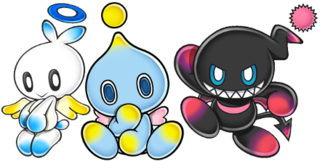
Chao are fictional life-forms in the Sonic the Hedgehog video game series published by Sega. They are small, childlike creatures that go through a complex life cycle and exist in several visual forms depending on how they are raised. Developer Sonic Team incorporated Chao into the games to encourage players to explore levels and support the good–evil dichotomy of Sonic Adventure 2.

Sonic Adventure 2 is a 2001 platform game developed by Sonic Team USA and published by Sega for the Dreamcast. It features two good-vs.-evil stories: Sonic the Hedgehog, Miles "Tails" Prower, and Knuckles the Echidna attempt to save the world, while Shadow the Hedgehog, Doctor Eggman and Rouge the Bat attempt to conquer it. The stories are divided into three gameplay styles: fast-paced platforming for Sonic and Shadow, multidirectional shooting for Tails and Eggman, and action-adventure exploration for Knuckles and Rouge.

Sonic Advance, known as SonicN on the N-Gage, is a 2001 platform game developed by Dimps and published by Sega for the Game Boy Advance. It was the first Sonic the Hedgehog game released on a Nintendo console with Sonic Adventure 2: Battle on the GameCube, and was produced in commemoration of the series' tenth anniversary. The story follows Sonic, Tails, Knuckles, and Amy as they journey to stop Doctor Eggman from taking over the world. Controlling a character, players are tasked with completing each level, defeating Eggman and his robot army, and collecting the seven Chaos Emeralds.
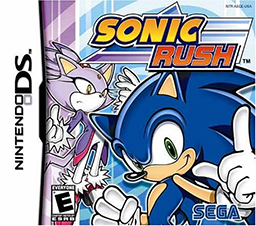
Sonic Rush is a 2005 platform game developed by Sonic Team and Dimps for the Nintendo DS as part of Sega's Sonic the Hedgehog series. It was released on November 15, 2005, in North America, November 18 in the PAL region, and November 23 in Japan, and was the final game in the mainline Sonic series to be produced by Yuji Naka before his departure from Sega. It is a 2D platform game, similar to earlier games in the series like Sonic Advance, as well as later ones like Sonic Mania. Levels in the game are side-scrolling and displayed using both of the DS's screens. However, boss battles, the main characters, and a special stage are rendered in 3D, creating a 2.5D effect. The game's storyline follows the intertwining adventures of the series' main character, Sonic the Hedgehog and a new character, Blaze the Cat. They respectively battle Doctor Eggman and his doppelgänger Eggman Nega at certain points.

Shadow the Hedgehog is a 2005 platform game developed by Sega Studios USA and published by Sega as part of the Sonic the Hedgehog series. The game follows its amnesiac titular character as he attempts to learn about his past, while an alien invasion plagues Earth. Shadow the Hedgehog reintroduces third-person shooter elements from Sonic Adventure and Sonic Adventure 2, but greatly expands upon the concept and introduces nonlinear gameplay to the Sonic franchise. To defeat enemies and progress through the game, Shadow can use a variety of weapons from each faction and complete missions that will determine the game's plot and subsequently playable levels.

Sonic Advance 3 is a platform video game developed by Dimps and Sonic Team and published by Sega for the Game Boy Advance in 2004. It is part of the Sonic the Hedgehog series, and the sequel to Sonic Advance 2. The game stars the characters Sonic, Tails, Knuckles, Amy, and Cream as they seek to keep Doctor Eggman and his robot assistant Gemerl from building empires on each of seven chunks Eggman has divided the Earth into.

Sonic the Hedgehog is a video game series and media franchise created by the Japanese developers Yuji Naka, Naoto Ohshima, and Hirokazu Yasuhara for Sega. The franchise follows Sonic, an anthropomorphic blue hedgehog who battles the evil Doctor Eggman, a mad scientist. The main Sonic the Hedgehog games are platformers mostly developed by Sonic Team; other games, developed by various studios, include spin-offs in the racing, fighting, party and sports genres. The franchise also incorporates printed media, animations, feature films, and merchandise.
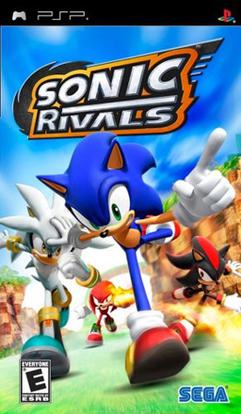
Sonic Rivals is a 2006 action-racing video game developed by Backbone Entertainment and Sega Studio USA, and published by Sega for the PlayStation Portable (PSP); it is a game in the Sonic the Hedgehog series, and follows the heroes needing to stop Doctor Eggman Nega from turning everyone and the world into cards. The gameplay involves racing against other characters to get to the goal before them, as well as defeating the boss before the opponent does.

Sonic Riders: Zero Gravity is a hoverboard racing video game developed by Sonic Team and published by Sega for the PlayStation 2 and Wii. It is the fifth pure racing game in the Sonic the Hedgehog series, and the second entry in the Sonic Riders trilogy, a spin-off of the main series.
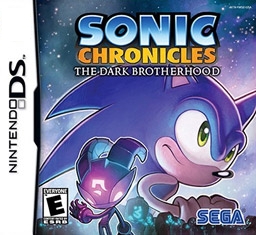
Sonic Chronicles: The Dark Brotherhood is a 2008 role-playing video game developed by BioWare and published by Sega for the Nintendo DS. It is a part of the Sonic the Hedgehog series, and is its only RPG entry. Sonic Chronicles initially focuses on the events surrounding the kidnapping of Knuckles and the disappearance of the Chaos Emeralds after the defeat of Doctor Eggman, before moving on to follow the cast of characters across two dimensions as they encounter a new ally, Shade the Echidna, and seek to stop the invasion of their world by Ix, the leader of Shade's tribe, the Nocturnus. The game is mainly played using the DS stylus, with players either exploring the overworld, or attacking with multiple characters in combat.

Doctor Ivo "Eggman" Robotnik is the main antagonist of Sega's Sonic the Hedgehog franchise. Eggman was created and designed by Naoto Ohshima as part of many design choices for Sega's new mascot. After the creation of Sonic the Hedgehog, Ohshima chose to use his previous egg-shaped character to create the antagonist of the 1991 video game Sonic the Hedgehog, making him the arch-nemesis of the series' eponymous main character.

Sonic Colors is a 2010 platform game published by Sega. It follows Sonic's quest to stop his nemesis Doctor Eggman from enslaving an alien race and taking over the world. The gameplay is similar to prior Sonic games, with players collecting rings and defeating enemies; the camera perspective often switches from third-person to side-scrolling perspectives. The game also introduces Wisps, power-ups the player can use to increase attack power and reach new areas.

Sonic Boom: Rise of Lyric is a 2014 action-adventure platform video game developed by Big Red Button and published by Sega for the Wii U. Along with Sonic Boom: Shattered Crystal for the Nintendo 3DS, it is a spin-off of Sega's Sonic the Hedgehog series and is a part of the Sonic Boom franchise, which also consists of an animated television series, a comic series by Archie Comics, and a toyline by Tomy. The storyline follows Sonic, Tails, Knuckles and Amy, who must stop Lyric the Last Ancient from acquiring the Chaos Crystals by powering up a robot army and wiping out all organic life, after Sonic accidentally awakens Lyric from a thousand year rest, while escaping Doctor Eggman.

Sonic Mania is a 2017 platform game published by Sega for Nintendo Switch, PlayStation 4, Xbox One, and Windows. Produced in commemoration of the Sonic the Hedgehog series' 25th anniversary, Sonic Mania pays homage to the original Sega Genesis Sonic games, featuring speedy side-scrolling gameplay. It takes place over 13 levels, including several redesigned from past games. The story follows Sonic, Tails and Knuckles as they venture to defeat their nemesis Doctor Eggman and his robotic henchmen, the Hard-Boiled Heavies.

Sonic Frontiers is a 2022 platform game developed by Sonic Team and published by Sega. As Sonic, the player explores the Starfall Islands to collect the Chaos Emeralds, after Sonic and his friends are separated when falling through a wormhole. Frontiers integrates traditional Sonic the Hedgehog elements—such as platforming, rings, and grind rails—into the series' first open world. While exploring the open world, players can complete challenges, fight robotic enemies, and access "Cyber Space" levels inspired by previous Sonic games.


















